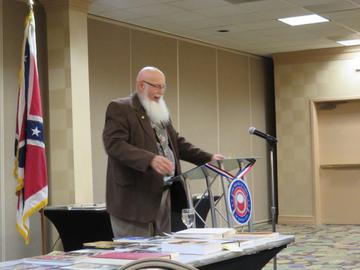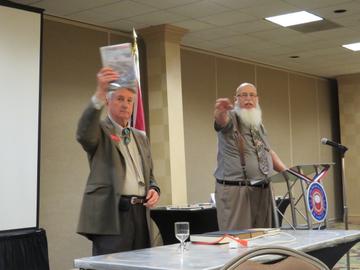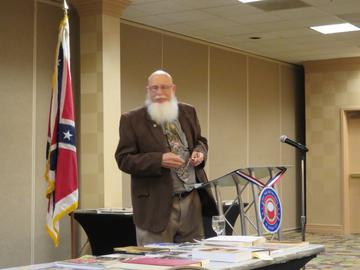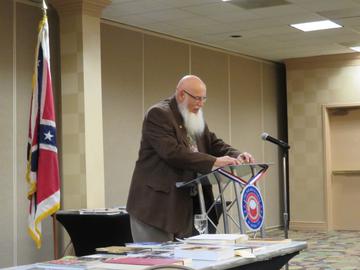|
|
|
|
January 2019

At our dinner meeting held on January 22, 2019, Arnold Schofield gave a very interesting presentation titled: "Legacies of the Civil War." The following are the key points of Arnold's presentation:
- John Brown foresaw the coming of the Civil War. Before going to the gallows in Charlestown VA on December 2, 1859, Brown handed one of his attendants a note which read: John Brown, am now quite certain that the crimes of this guilty land can never he purged away hut with blood...."
- In 1861, neither the United States nor the Confederate States were prepared for war. Both sides underestimated the other side. The belief was the south could have won a short war, whereas the north had an industrial complex that could support a long war.
- During the war, the south had no way to mass-produce horse shoes or even shoes for their soldiers.
- The battle between the Monitor and the Merrimack began the age of iron-clad ships.
- Fire arms evolved from smooth bore muskets to rifled weapons, which could kill at a greater distance. The Henry rifle and the Spencer rifle are repeating rifles that were used during the Civil War. The U.S. Army adopted the Spencer rifle from 1865-1872.
- The Gatling gun was invented and used during the Civil War and was a precursor to the machine guns used during World War I.
- In 1862, the Homestead Act was passed. This opened up settlement in the western U.S. and allowed any American, including freed slaves, to put in a claim for up to 160 acres of federal land.
- Cyrus McCormick patented the McCormick Reaper in 1834. This was a horse-drawn implement primarily used to harvest small grain crops. There was also competition for the best steel-bottomed plow to better clear the prairie.
- Before the Civil War, cattle from Texas were sold to western meat markets. During the Civil War, Kansas became the center of the cattle industry and the cattle were sold to eastern meat markets.
- During the Civil War, thousands of miles of track were laid in the north and the Baldwin Locomotive Works in Philadelphia was kept extremely busy. The south had different gage railroads and couldn't produce their own rails. Therefore, short railway lines were destroyed, in order to maintain the main railway lines.
- After the Civil War there were 2 million Union veterans. The U.S. government started a pension bureau, which evolved into the VeteransAfter the Civil War there were 2 million Union veterans. The U.S. government started a pension bureau, which evolved into the Veterans Administration. The southern states had their own pension system. Southern soldiers were treated as heroes after the war. The Union veterans were not treated the same. The Union soldiers had a hard time finding work and alcoholism was a problem.
- The National Cemeteries Act was passed in 1862 and 14 military cemeteries were established. Approximately 750,000 soldiers died during the Civil War. About half are buried in graves marked as unknown.
- In the north there was public education. However, in the south there were no public schools. In 1865, there were 4 million former slaves that could not read or write. Congress established the Freedmen's Bureau, in order to help former slaves and poor whites in the south after the Civil War. African-American colleges such as Storer College in Harper's Ferry and Tuskeegee University in Alabama were started.
- he Reconstruction Era took place from 1865-1877. The purpose of reconstruction was to help rebuild the southern states and return them to the Union. During this period there was a second war in the south. The southern states wanted to preserve their culture and way of life with white supremacy on top and the former slaves on the bottom. The south won this war.
- In 1866 the first Civil Rights Act was passed by Congress. This act made citizens of all former slaves. This also gave them the right to vote. However, this infuriated the south and led to intimidation of the former slaves and the establishment of terrorist organizations such as the KICK, and the Night Riders.
- From 1866-1868 many African-Americans were elected to state legislatures. However, after 1869, they didn't run again due to intimidation.
- he 13th Amendment was passed in 1865, which abolished slavery. The 14th Amendment was passed in 1868, which guaranteed U.S. citizenship to all persons born or naturalized, granting civil rights. The 15th Amendment was passed in 1870, which guaranteed the right to vote.
- The Civil War was not over in 1865. It took five years for the all of the Confederate States to rejoin the Union. Tennessee was the first state readmitted to Congress in 1866. Six states were readmitted in 1868 and the last four states were readmitted in 1870.
- President Rutherford B. Hayes ended Reconstruction in 1877 by withdrawing all military from the southern states.
- After the war, the north called it the "Civil War" or the "War of Rebellion." The south called it the "War of Northern Aggression", the "War Between the States", or the "War of Southern Independence."
- The "Lost Cause of the Confederacy" is an ideology that holds that despite losing the war, the Confederacy was a just and heroic cause. The Civil War was a struggle for the southern way of life or states’ rights, in the face of overwhelming northern aggression. The "Lost Cause" denies the central role of slavery in the outbreak of the war.
- Many southerners deny that slavery was ever a cause of the Civil War. They claim that the south fought the war because of states' rights. However, states' rights was not claimed prior to 1865. In the U.S. Constitution there is nothing mentioned about states having the right to secede from the Union.
- In 1876, slavery had another name: "sharecropping." Former slaves could never get out of debt. This led to the Exoduster Movement of 1879. Former slaves left the south and traveled up the Mississippi River to St. Louis before heading west to Kansas.
- Following the Civil War, a number of organizations were established including the Grand Army of the Republic (1866), the Sons of Union Veterans of the Civil War (1881), the United Confederate Veterans (1889), the Sons of Confederate Veterans (1896), the United Daughters of the Confederacy (1894). The veterans used to talk about courage and honor on both sides. However, nobody ever reconciled. It was always: "We were right and they were wrong."
- Mildred Lewis Rutherford (1851-1928) was a prominent educator and a prolific non-fiction writer from Athens GA. She was a tireless advocate of the "Lost Cause" version of southern history and she rewrote the history of the Civil War from the southern perspective. The history books that she wrote were used in the south until the 1960's.
- General Robert E. Lee wanted to restore his citizenship in the U.S. and signed an amnesty oath on October 2, 1865. He filed an application through U. S. Grant's office. Secretary Seward gave the paper to an aid and it then disappeared. In 1970, an archivist found the record at the National Archives. The U.S. House of Representatives restored Lee to citizenship of the U.S. on July 22, 1975 and President Gerald Ford signed the resolution on July 24, 1975.
- The December issue of the Smithsonian Magazine has an article titled: "The Costs of the Confederacy." The article states that in the last ten years, the American taxpayers have spent at least S40 million on Confederate monuments and groups that perpetuate racist ideology. The article condemns many Confederate museums in the south, including Jefferson Davis' home. Money is being spent, but it is state money. In the south the Civil War is being taught of Confederate honor and courage. However, they do not address disenfranchisement of African-Americans.
|

Arnold Schofield performing double duty at the January meeting. Don Bates helping with the book auction.
|
 |
 |
|
| |
|
|
|
|
|
|